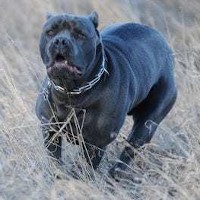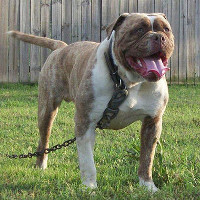Appearance of the Blue Blood Cane Corso
|
| The Alapaha Blue Blood Bulldog has distinctive features that set it apart from other Bulldog-type dogs. It is described as an exaggerated Bulldog with a broad head and muscular, robust body. The Alapaha's coat is short and stiff. It is usually blue merle, brown merle, red merle with white or chocolate and white trim. An exceptional physical characteristic of the Alapaha is its eyes. The Alapaha will often have glass eyes (blue) or marble eyes (brown and blue mixed in one eye). This breed also has cat-like paws. The Cane Corso has a short, stiff coat, so it's likely that the offspring will also have a short, stiff coat. The Cane Corso varies in color from black, gray, red or fawn. Some Corsos have a brindle pattern. The color of the Blue Blood Cane Corso will vary. He will be tall and muscular with powerful jaws and a broad skull. It may or may not have the glass eyes characteristic of the Alapaha, it may show the marble eyes that are also remarkable for the Alapaha. |
Temperament of the Blue Blood Cane Corso
|
| The Alapaha is a superb guardian. It is conscientious and easily trained. It will fight to the death to defend its family, but is gentle with children. It's important to maintain a relationship with the Alapaha in which you are the leader of its pack. It is extremely loyal to its family and very protective. The Cane Corso is highly intelligent, but can be authoritarian. He needs a confident, firm and consistent handler who will be calm and quiet when giving orders. This is not an aggressive dog with the right training. In fact, they are normally docile and affectionate with all their family, including children. However, they need to be socialized from an early age. The Cane Corso can suffer from separation anxiety, so it's a good idea when he's younger to give him some time alone, perhaps in a fenced yard, so he learns that he'll be fine on his own and that his family will return. Given the personality traits of both parent breeds, it's likely that the Blue Blood Cane Corso will need early socialization in order to learn how to act properly or react to various situations. It will also need a firm, consistent and gentle handler who will always be calm when carrying out commands. He will be highly intelligent and alert, very loyal and protective of all family members. He may have a tenacious streak. Consistency is the key to maintaining a good relationship with the Blue Blood Cane Corso. |
Needs and activities of the Blue Blood Cane Corso
|
| The Alapaha Blue Blood Bulldog parent breed needs a moderate amount of exercise. It will do well in an apartment if given sufficient daily exercise. Bulldogs tend to become inactive indoors, so you'll need to start some activity. The Cane Corso should never be allowed to be tied up or put on a chain. However, he does need sufficient physical activity to stay healthy. It should be walked twice a day, morning and evening. The Cane Corso also needs mental stimulation in addition to physical activity. He's always good at herding cattle, which is an excellent way of stimulating mental activity. You can also work with him on obedience commands or learning tricks. Considering the needs of each parent breed, the Blue Blood Cane Corso will probably need at least an hour of activity a day. He'll need both physical activity and mental stimulation. It's not a good idea to leave your Blue Blood Cane Corso tied up; it will need a secure, fenced-in yard to move around in. This will also ensure that any animals that may wander onto your property don't come into contact with your dog. |
Maintenance of the Blue Blood Cane Corso
|
| The Blue Blood Cane Corso is likely to have a short, wiry coat, like both its parents. The Cane Corso is a dog that sheds a lot, so owners need to be prepared for this. In fact, it's likely to shed a lot at least twice a year. Weekly brushing with a stiff brush is recommended. Only bathe your Blue Blood Cane Corso when necessary, as you risk stripping the natural oils from its coat. You should brush your pet's teeth at least three times a week; however, if you want to prevent gum disease, brush your dog's teeth every day. Trim your dog's nails every two weeks. As a general rule, if you hear your dog's nails clicking on the floor, it's time to trim them. |









 English (United Kingdom)
English (United Kingdom)